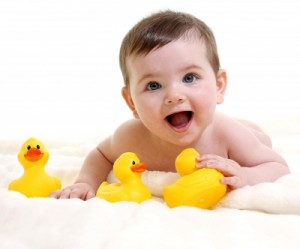Green Products
Green diapers can reduce landfill waste and save you money.
Have you ever wondered how many diapers a baby uses as they grow into a sweet little child? Conservatively, a baby uses 4,702 diapers in the first two years of their lives. If you consider that our precious little ones sometimes need extra diaper changes and that many babies are not potty trained by two years of age, then we assume a baby can use about 5,000 or more diapers as they grow. Each day, about 50 million diapers are tossed out to the landfill or 3.2 million tons per year and each disposable diaper takes up to 500 years to fully biodegrade. With disposable diapers being the most common diaper used today, switching to green diapers can truly reduce the environmental impact our little ones produce.
 Choosing the right green diapers for your babies can be a dirty job, but you can wipe the problem out with a little bit of research. There are two common types of green diapers; biodegradable diapers and cloth or organic cloth diapers. There are pros and cons to each type of diaper and every parent needs to consider all the facts before making their final decision. While we want everyone to be green and live a sustainable lifestyle we understand that you have to consider convenience, baby comfort and price before switching to a green product. Let’s review those considerations for these types of diapers so an informed decision can be made.
Choosing the right green diapers for your babies can be a dirty job, but you can wipe the problem out with a little bit of research. There are two common types of green diapers; biodegradable diapers and cloth or organic cloth diapers. There are pros and cons to each type of diaper and every parent needs to consider all the facts before making their final decision. While we want everyone to be green and live a sustainable lifestyle we understand that you have to consider convenience, baby comfort and price before switching to a green product. Let’s review those considerations for these types of diapers so an informed decision can be made.
First of the two common types of green diapers are the biodegradable diapers; these green diapers are made from natural fibers such as cotton or sustainable tree-farmed fluff pulp and most importantly without any plastics. Many biodegradable diapers can be flushed down the toilet and later will be treated at the wastewater treatment plant where nutrients can be recovered and used for fertilizer. They can also be composted and turned into fertilizer for gardening but if they’re tossed out to the landfill, they will degrade between 50-150 days versus the 500 years of disposable diapers.
How about the price of biodegradable diapers? When I did the research on the price of biodegradable diapers, I was surprised to find that they’re not significantly more expensive than the traditional disposable diapers. For example, a gDiapers’ gRefills costs $0.05 more per diaper than a comparable Pampers brand diaper for an equivalent size. It may be worth a nickel to reduce the waste of 5000 diapers sitting in the landfill for 500 years.
Find Green Diapers for Your Baby
If you want a cheaper option, the original green diaper is an alternate choice if you don’t mind doing some washing. Cloth diaper producers have recently reported sales increases by 25% or more as the green initiative and economy has boosted their popularity. They can be made of Merino wool, water resistant nylon or synthetic materials. Cloth diapers also come as organic cloth diapers that are made from organic cotton. Cloth diapers are washable and reusable meaning almost no impact to the landfills. As noted above, cloth diapers need to be washed, if done on inefficient washing machines and a tumble dryers there are arguments that the greenhouse gases produced offset the gains of reducing landfill waste. This is easily overcome by line drying the diapers and some cloth diapers even come with flushable liners. The flushable liners capture the dirty mess while allowing the wetness to pass through so that you don’t have to rinse before washing them. Cloth diapers can cost less than $300 over baby’s early years, a far cry from the $1,250 or more spent on traditional disposable diapers.
Biodegradable diapers and cloth diapers are both great eco-friendly choices when it comes to green diapers. Whichever option you chose it will greatly help the environment making the Earth a cleaner place for future generations.